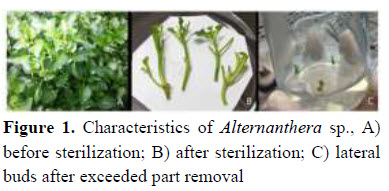Optimal medium for watercress (Alternanthera sp.) micropropagation
Keywords:
Alternanthera sp., Micropropagation, Sodium hypochlorite, BenzyladenineAbstract
The objective of the present study was to find the optimal conditions for micropropagation of Alternanthera sp. The first experiment aimed to find the optimal sterilization of lateral bud meristems for in vitro culture. The results revealed that the best sterilization technique is to clean lateral bud meristem by bending shoot and dipping in 70% ethanol for 1 min. These shoots were then removed and immersed in 3% sodium hypochlorite solution for 10 min. This sterilization technique provided the highest survival percentage of 95% and the best microorganism removal. The second experiment aimed to determine the effects of the plant growth regulators
benzyladenine (BA) on shoot proliferation. The shoot induction of sterile lateral bud meristems of Alternanthera sp. was then carried out in Murashige and Skoog (MS) media supplemented with benzyladenine (BA) at five different concentrations (0, 1, 2, 3 and 4 mg/l) under 25±2 °C and light condition for 4 weeks. It was found that MS media supplemented with 3 mg/l BA induced the optimal growth and development of shoots. This condition provided the highest root induction and the significant average shoot of 12.88±0.51 shoots/explant (p<0.05). The results from the present study could be the basic information for producing aquatic plants that have economic value and genetic conservation. In additions, it may be useful for biological activity tests or provide the possibility for callus induction for further somatic embryo culture technology.
References
Dutta, P. (2015). Pharmacognostical evaluation and preliminary phytochemical analysis of Alternanthera philoxeroides. International
Journal of MediPharm Research, 1(1), 7-13.
Flores, R., Flôres, P. Z., Bempck, S. G., Maldaner, J. & Marchioretto, M. S. (2016). In vitro clonal propagation of the endangered plant
Alternanthera hirtula (Amaranthaceae). International Journal of Current Research, 8(12), 43522-28.
Jiang, W. L., Yang, Z. Q., Chen, W., Xiao, H. & Luo, X. L. (2007). Effects of Alternanthera philoxeroides griseb against respiratory syncytial virus infection in mice. Nan Fang Yi Ke Da Xue Xue Bao, 27(1), 62-4.
Kopsell, D. A., Barickman, T. C., Sams, C. E. & McElroy, J. S. (2007). Influence of nitrogen and sulfur on biomass production and carotenoid and
glucosinolate concentrations in watercress (Nasturtium officinale R. Br.). Journal of Agricultural and Food Chemistry, 55(26), 10628-34.
Kumar P. S., Dheeba, B., Stalin, S., Maragatham, M. & Kannan, M. (2011). Hypoglycemic and antihyperlipidemic activity of leaves and stems
of Alternanthera philoxeroides in alloxan induced diabetes. Journal of Phamacy Research, 4(6), 1793-5.
Lee, W.L. & Chan, L.K. (2004). Plant regeneration from stem nodal segments of Orthosiphon stamineus Benth., a medicinal plant with diuretic
activity. In Vitro Cellular & Developmental Biology-Plant, 40(1), 115-118.
Majumder, S., M, Rashid, Md. H. Al., Chowdhury, S., Gupta, B. K. & Mandal, S. C. (2016). Physiochemical and antioxidant assay of ayurvedic formulations of Althernanthera philoxweroides. International Research Journal of Pharmacy, 7(5), 20-3.
Montri N., Juthamas, P. & Sukumalanandana, C. (2000 ). Tissue culture of Phyllanthus emblica Linn. Bangkok, Kasetsart University Press.
Murashige, T. & Skoog, F. (1962). A revised medium for rapid growth and bioassay with tobacco tissue cultures. Physiologia Plantarum,
, 473-97.
Nin, R. J. (1986). A study of the preservative and therapeutic effects of Alternanthera philoxeroides on influenza. Zhong Xi Yi Jie He
Za Zhi, 6, 29-30.
Pikulthong, V., Teerakathiti, T., Thamchaipenet, A. & Peyachoknagul, S. (2016). Development of somatic embryos for genetic transformation in
Curcuma longa L. and Curcuma mangga Valeton and Zijp. Agriculture and Natural Resources, 50(4), 276-85.
Pongchawee, K., Chusang, P. & Tong-mee-aied, W. (1999). Tissue culture of Cryptocoryne tonkinensis Gagnepain. In proceeding of the
annual conference on Fisheries 1999. Bangkok, Department of Fisheries, Ornamental Fish Research Institute and Public Aquarium.
Pongchawee, K., Pasugdee, S., Pradissan, R., Pipatcharoenchai, W. & Kanthrong, W. (2012). Micropropagation of melon swordplant (Echinodours osiris Rataj, 1970). In proceeding of the annual conference on Fisheries 2012, 6-7
June 2012, 5-20, Bangkok, Department of Fisheries.
Rattanathongkom, A., Sripanidkulchai, B. & Kanchanapoom, T. (2008). Immunomodulating Activity of Chikusetsusaponin IVa from
Alternanthera philoxeroides. Isan Journal of Pharmaceutical Sciences, 4(2), 113-120.
Rawdkhao, T. (2000). In vitro culture of Eucalyptus silver dollar tree (Eucalyptus cinerea F. Muell.ex Benth). (Unpublished master thesis). Kasetsart University, Bangkok.
Sakakibara, H. (2006). Cytokinin: Activity, biosynthesis, and translocation. Annual Review of Plant Biology, 57, 431-49.
Shekhawat M. S., Manokari, M. & Revathi, J. (2017). In vitro propagation, micromorphological studies and ex vitro rooting of Alternanthera
philoxeroides (Mart.) Griseb.: an important aquatic plant. Aquaculture International, 25(1), 423-35.
Tanthai, S., Pongchawee, K., Rachada, S., Anantasaran, J., Mansuriwong, P. & Tanthai P. (2015). Cultivation and propagation of Cryptocoryne. (Publication No. 2554A15662011). Retrieved from http://ird.skru.ac.th/RMS/show_research.php?id=277
Zhang, S. M., He, Y. S., Tabba, H. D. & Smith, K. M. (1988). Inhibitor against the human immunodeficiency virus in aqueous extracts of Alternanthera philoxeroides. Chinese Medical Journal (Engl), 101, 861-6.
Zhang, W., Swarup, R., Bennett, M., Schaller, G. E. & Kieber, J. J. (2013). Cytokinin induces cell division in the quiescent center of the Arabidopsis root apical meristem. Journal of Current Biology, 23(20), 1979-89.













